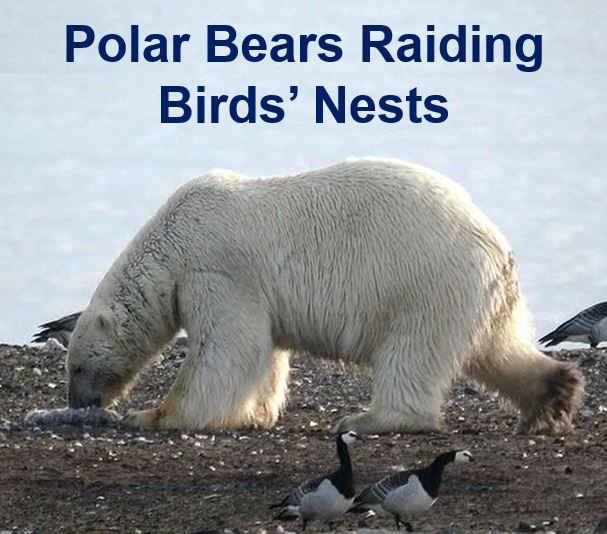Melting Arctic ice means there are fewer hunting seals, the main food supply of polar bears, which have been forced to raid the nests of seabirds for eggs, a new study has found. Biologists from Norway, the Netherlands, Germany, France and Poland say polar bears are now starting to raid birds’ nests a month earlier than they used to 10 years ago.
The researchers wrote in the academic journal Frontiers in Ecology and Evolution (citation below) that the Arctic is warming up rapidly. The shrinking of sea ice is currently transforming the habitat of top-predators that rely on the ice.
Polar bears (Ursus maritimus), the region’s top predator, rely on sea ice for hunting seals. In this study, the researchers set out to determine whether the hypothesis – that longer ice-free seasons force the animals to hunt for alternative food, such as the eggs of colonial breeding birds – is true.

Polar bear feeding on eggs in a breeding colony of barnacle geese on Spitsbergen. The geese watch helplessly as their nests are emptied. (Credit: Jouke Prop)
They gathered and analyzed time-series polar bear observation data at four locations on Spitsbergen (Svalbard) and one in east Greenland.
Since the 1970s, the summer occurrence of polar bears, measured as the likelihood of encountering bears and the number of days with bear presence, has risen considerably. The increase in polar bear occurrence has coincided with the shortening of sea-ice seasons and less sea ice during the spring in the areas studied.
The authors wrote:
“This resulted in a strong inverse relationship between the probability of bear encounters on land and the length of the sea ice season.”
“Within, 10 years after their first appearance on land, polar bears had advanced their arrival dates by almost 30 days.”
In this context, inverse relationship refers to two variables or parties that move in opposite directions. An inverse relationship may also be an indirect relationship.
Polar bears may threaten birds’ breeding success
According to direct observations of nest predation, the researchers wrote that polar bears might significantly affect the breeding success of the glaucous gull, common eider and barnacle goose.
Attacks on nests were strongest in the years when the bears arrived well before the birds hatched, when more than 90% of all nests were predated.
Lead author, Dr. Jouke Prop, who works at the faculty of Arctic studies at the University of Groningen in the Netherlands, said:
“When a new predator enters the scene, the delicate balance between predators and their prey may be perturbed. Polar bears colonizing coastal areas, from which they have been absent for a long time, is an example of this situation.”
Studies in Canada had similar findings with climate and subsequent habitat change.
The authors concluded in an Abstract in the journal:
“We suggest that the increasing, earlier appearance of bears on land in summer reflects behavioral adaptations by a small segment of the population to cope with a reduced hunting range on sea ice.”
“This exemplifies how behavioral adaptations may contribute to the cascading effects of climate change.”
Citation: “Climate change and the increasing impact of polar bears on bird populations,” Prop J, Aars J, Bårdsen B-J, Hanssen SA, Bech C, Bourgeon S, de Fouw J, Gabrielsen GW, Lang J, Noreen E, Oudman T, Sittler B, Stempniewicz L, Tombre I, Wolters E and Moe B. Frontiers in Ecology and Evolution. Published on 25 March, 2015. DOI: 10.3389/fevo.2015.00033.
